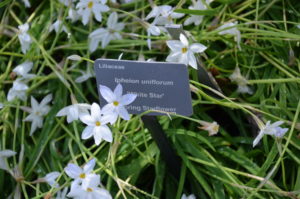Spring star flowers (Ipheion uniflorum), native to Argentina and Uruguay, feature grass-like foliage and 6-petaled star-shaped flowers on 3-6 inches tall stems in early spring (April). Each bulb produces multiple flowering stems. Flowers range in color from almost white to violet blue and emit a mild spicy fragrance. In addition the grassy foliage gives off an oniony or garlic aroma when crushed. They are in the Liliaceae plant family and their scent repels deer and rabbits.
Star flowers are one of the easiest bulbs to grow. These minor bulbs grow in average, medium, well-drained soils in full sun to part shade. They’re tolerant of a wide range of soils. In fall, sow bulbs 2-4 inches deep and 2-4 inches apart. Bulbs naturalize rapidly by bulb offsets and also by self-seeding. Plants go dormant by late spring. Lightly feed the planting in early spring with 10-20-10 or equivalent fertilizer.
Bulbs may start out slowly the first year, but star flowers eventually naturalize. Once established, star flowers produce masses of quarter size blooms lasting 3-4 weeks even if planted in the home lawn. Star flowers flourish in the Southeastern U.S. west to Texas (USDA hardiness zones 4-9).
Star flowers are great planted in a rock garden, containers, front borders or mixed among peonies, heucheras, hostas, et al. Sow masses of bulbs under recently planted shade trees. Branches should be limbed up high enough to permit the early spring sunlight to filter down to the bulb foliage.
I have found the largest variety selection listed in Brent and Becky’s fall catalog @Brent and Becky’s Bulb, Inc. in Gloucester, VA. A few favorites include: ‘Jessie’ (described as the darkest blue); ‘Rolf Fiedler’ (bright deep blue), ‘Tessa’ (light pale blue), ‘White Star’ White stars), and ‘Wisley Blue’ (variable shades of blue).
Decorate your spring kitchen table with a small vase of these beauties.


 Posted in
Posted in 
